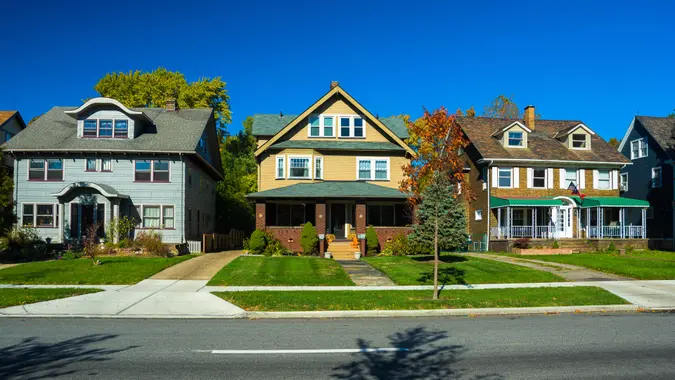Ramit Sethi: Use This Number To Know If You Can Afford a House (It’s Not the Mortgage)

Commitment to Our Readers
GOBankingRates' editorial team is committed to bringing you unbiased reviews and information. We use data-driven methodologies to evaluate financial products and services - our reviews and ratings are not influenced by advertisers. You can read more about our editorial guidelines and our products and services review methodology.

20 Years
Helping You Live Richer

Reviewed
by Experts

Trusted by
Millions of Readers
How much home can you afford? It’s easy enough to plug your information into an online mortgage calculator and get an answer. But relying on that information can be financially dangerous — at least, according to expert Ramit Sethi.
In a recent newsletter, he shared the number he actually looks at when deciding whether he can afford a home.
Ramit Sethi’s Rule of 50%
Sethi’s home-buying rule is relatively straightforward: He simply adds 50% to a home’s sticker price. So, if he were thinking of buying a $1 million home, Sethi would calculate whether he could afford it as if he was paying $1.5 million.
The goal behind this is to get a more accurate representation of what the house will cost to own. Industry analysts say the average homeowner pays $18,000 in “hidden costs” per year. That’s $540,000 over a 30-year mortgage.
These costs include:
- Property taxes
- Home insurance
- Ongoing maintenance and repairs
- Cleaning services
- Landscaping companies
Sethi’s main point is that you shouldn’t buy a home without accounting for these expenses. That can be hard to do, since hidden costs are by nature tough to plan for. The 50% rule is an easy way to account for homeownership expenses you can’t predict accurately today. Following it can help you make a smarter purchase based on your budget.
What If You Can’t Afford To Add 50% to Your Home Price?
Now that you know Sethi’s rule, the obvious follow-up is, what if it doesn’t work for you? Not everyone can afford to price an additional 50% into their home-buying process — especially after the massive growth in U.S. median sale prices over the last 50 years.
Sethi advised continuing to rent if you can’t follow the 50% rule. He wrote that he’s been renting for the last 20 years and greatly appreciates not having to pay for repairs, renovations and other hidden expenses.
About 34% of U.S. households belong to renters, Forbes Advisor reported. Some of these renters are wealthy people who simply don’t want to deal with the hidden costs of home ownership. That could be what’s best for your current-day financial situation, too — even if buying a house has been a dream.
5 Questions To Ask When Buying a House
In the same newsletter, Sethi shared five additional questions people should ask before purchasing a new home. Using these will help you make a more informed buying decision. In fact, Sethi said if your answer to any of the following questions is a “hard no,” you shouldn’t buy the home.
Will I Live Here for at Least 10 Years?
First, consider how long you plan on staying in the home. Longer tends to be better financially, though every situation differs. For Sethi, 10 years is the threshold. If you can’t honestly say you’ll remain in the home for at least that long, you shouldn’t buy it.
Will Housing Cost Lower Than 28% of My Monthly Income?
Next, consider what percentage of your monthly income housing would account for. Remember to use Sethi’s rule of 50% when calculating it. For example, if your mortgage is $3,000, you should actually think of it as $4,500. Buying a home may not be a wise financial decision if it costs more than 28% of your monthly income.
Can I Pay 20% for a Down Payment?
If you don’t put 20% down on your new home, you may need to buy private mortgage insurance. This can add hundreds of dollars to your monthly mortgage payment — only because you didn’t put down enough upfront cash when buying the property.
If you can’t pay 20%, Sethi said to wait until you can. Doing so may not be ideal, but the sacrifice could pay financial dividends for years.
Will I Be OK If My House’s Value Goes Down?
Next, Sethi said to consider how you’d feel if the house’s value decreases. If you wouldn’t mind very much, that’s a great sign. But if a sudden drop in price puts you on edge or ruins you financially, buying the home may not be worth it.
Median U.S. home prices have climbed consistently for years. But housing crashes happen — just think back to 2008. You shouldn’t buy a home if you would have to sell in a crash to limit your financial losses. That could set you back years, financially.
Am I Excited About Buying?
Finally, Sethi wants people to consider how they feel about buying the property they’re looking at. Is it exciting? Or do you feel dread at the work and stress to come? That answer could also influence whether purchasing is right for you.
Homeownership is an expensive process that can come with a lot of unexpected work. You want to make sure the reward for all of that is worth it to you. Otherwise, you may simply be better off continuing to rent.
 Written by
Written by  Edited by
Edited by 

























